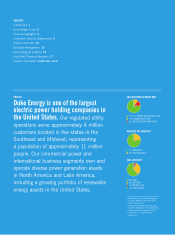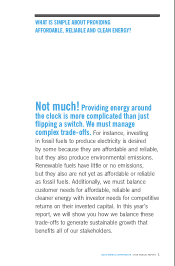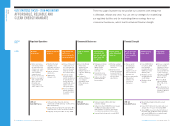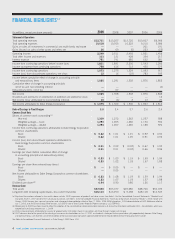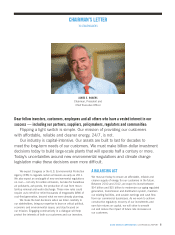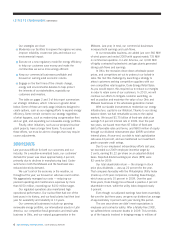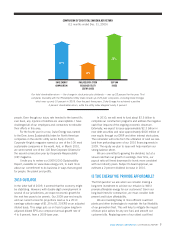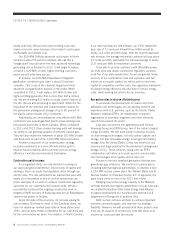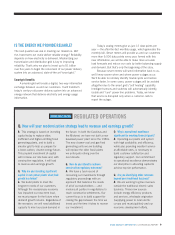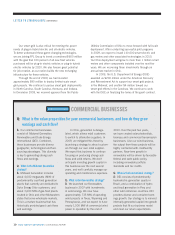Duke Energy 2009 Annual Report Download - page 11
Download and view the complete annual report
Please find page 11 of the 2009 Duke Energy annual report below. You can navigate through the pages in the report by either clicking on the pages listed below, or by using the keyword search tool below to find specific information within the annual report.
10 DUKE ENERGY CORPORATION / 2009 ANNUAL REPORT
STRATEGIC FOCUS COMMERCIAL BUSINESSES
Our smart grid is also critical for meeting the power
needs of plug-in hybrid electric and all-electric vehicles.
To better understand these game-changing technologies,
we are joining FPL Group to invest a combined $600 million
with the goal that 100 percent of all new fleet vehicles
purchased will be plug-in electric vehicles or plug-in hybrid
electric vehicles by 2020. We also foresee great potential
for job creation, as our nation builds the new recharging
infrastructure for these vehicles.
Through the end of 2009, we had invested
approximately $90 million to deploy limited-scale smart
grid projects. We continue to pursue smart grid deployments
in North Carolina, South Carolina, Kentucky and Indiana.
In December 2008, we received approval from the Public
Utilities Commission of Ohio to move forward with full-scale
deployment. After conducting successful pilot programs
in 2009, we expect to install 140,000 smart electric and
gas meters and other associated technologies in 2010.
Our Ohio deployment will grow to more than 1 million smart
meters and other components installed over the next five
years. We are recovering these investments through an
annual rate tracker in Ohio.
In 2009, the U.S. Department of Energy (DOE)
awarded us $200 million under the American Recovery
and Reinvestment Act to support our smart grid projects
in the Midwest, and another $4 million toward our
smart grid efforts in the Carolinas. We continue to work
with the DOE on finalizing the terms of the grant contract.
LETTER TO STAKEHOLDERS (CONTINUED)
A: Our commercial businesses
consist of: Midwest Generation,
Renewables and Duke Energy
International (DEI). Combined,
these businesses provide diverse
geographic, technological and fuel-
sourcing advantages. This diversity
is key to generating strong cash
flows and earnings.
Q: What is the Midwest Generation
strategy?
A: Midwest Generation includes
about 4,000 megawatts (MW) of
predominantly coal-fired generation
plants that currently are dedicated to
Duke Energy Ohio customers, and
about 3,600 MW of gas-fired plants
located in Ohio and other Midwestern
states that serve wholesale markets.
This is a mature business that has
historically provided good cash flows
and earnings.
In Ohio, generation is deregu-
lated, which allows retail customers
to switch to alternative suppliers. In
2009, we mitigated this threat by
launching a strategy to attract custom-
ers through our own retail supplier.
We expect this business to continue
focusing on producing strong cash
flows and solid returns. We don’t
anticipate investing growth capital in
this business over the next several
years, and we’ll carefully manage our
operating and maintenance expenses.
Q: What is the Renewables strategy?
A: We launched our Renewables
business in 2007 with investments
in wind energy. We now have
approximately 735 MW of operating
wind projects in Texas, Wyoming and
Pennsylvania, and we expect to have
nearly 1,000 MW of commercial wind
power in operation by the end of
2010. Over the past two years,
we have created solar photovoltaic,
biomass and commercial transmission
businesses. Like our wind business,
the output from these projects will be
highly contracted with creditworthy
partners. Near-term growth in
renewables will be driven by favorable
federal and state public policy,
including renewable portfolio
standards and tax credits.
Q: What is the International strategy?
A: DEI consists of predominantly
hydroelectric generation assets in
Brazil, and a combination of hydro
and fossil generation in Peru and
other Latin American countries. DEI
provides diverse and consistent earn-
ings growth. Our strategy is to reinvest
internally generated capital into growth
projects that fit our business model
and meet our return expectations.
Q: What is the value proposition for your commercial businesses, and how do they grow
earnings and cash flow?


